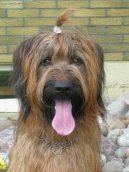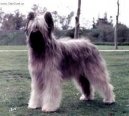Briard (Dog standard)
Briard is a hardy dog, supple, muscular and well proportioned, of vigorous movement, balanced temperament, neither aggressive nor timid.
Standard FCI No 113 / 09.11.1995 / GB
Briard (Berger de Brie)
TRANSLATION: Mrs. Peggy Davis
ORIGIN: France.
DATE OF PUBLICATION OF THE VALID ORIGINAL STANDARD: 06.05.1988
UTILIZATION: Sheepdog.
FCI Classification:
Group 1: Sheepdogs and Cattle Dogs (except Swiss Cattle Dogs)
Section 1: Sheepdogs
With working trial
GENERAL APPEARANCE:
Hardy dog, supple, muscular and well proportioned, of vigorous MOVEMENT, balanced temperament, neither aggressive nor timid.
Penalisation: Aggressive, soft, timid, clumsy.
SIZE:
0,62 m to 0,68 m for males; 0,56 m to 0, 64 m for females
The length of the BODY must be more important than the height at shoulders. The GENERAL APPEARANCE of the Briard is rangy.
Penalisation: Cobby dog: no Excellent. SIZEs superior to 0,68 m and 0,64 m.
Disqualification: Below the minimum. More than 2 cm above the maximum SIZE. All subjects not reaching the minimum SIZE cannot be confirmed.
HEAD:
Strong, long, pronounced stop midway between the top of the HEAD and the tip of the nose, furnished with HAIR forming beard, moustache and eyebrows slightly hiding the eyes.
Penalisation: Short HEAD, too long, no balance between muzzle and skull. Disproportion between HEAD and BODY. HAIRy HEAD to the extent of hiding the shape; beard, moustache and eyebrows insufficient, stop too pronounced or non-existent.
Disqualification: The above mentioned FAULTS too pronounced.
ForeHEAD: Very slightly rounded.
Penalisation: Too flat, too rounded, too broad, sloping on the eyes.
Top of muzzle: Nasal bridge flat.
Penalisation: Too long, weak, too short. Nasal bridge convex (Roman nose).
Muzzle: Neither narrow nor pointed.
Penalisation: Pointed, narrow or too thick, pendulous flews.
Nose: More square than round, always black, strong and open.
Penalisation: Small nose, pinched, pointed, other than black or with traces of pink.
Disqualification: Brown or lighter COLOURed nose, pink.
Teeth: Strong, white and perfectly adapted.
Penalisation:
Absence of 1 incisor
Defective mouth, slight prognathism without loss of contact.
Absence of 1 premolar
Absence of 2 incisors
Absence of 2 premolars
Disqualification: Pronounced prognathism with loss of contact. Absence of 2 premolars 4 (PM4) on the lower jaw or absence of altogether 3 teeth whatever they are.
Eyes: Horizontal, well opened, quite large, not slanting, of dark COLOUR, intelligent and calm expression. A grey eye in a grey dog is not to be penalized.
Penalisation: Eye too small, almond shaped or of a light COLOUR.
Disqualification: Eyes dissimilar, haggard, too light in COLOUR.
Ears: Set high, preferably cropped and carried erect; not flat against the HEAD and rather short if uncropped. At equal quality, preference shall be given to the dog whose erect carried ears have been cropped. The length of the uncropped ear must be equal or slightly less than half the length of the HEAD, always flat and covered with long HAIR.
Penalisation: Covered with too short HAIR, too long, carried badly.
Disqualification: Twisted ears, set too low below the eye-line, covered with short HAIR, naturally erect, graft of cartilage.
NECK: Muscular and disengaged from the shoulders.
Penalisation: Reach of NECK too long, frail or too short.
BACK: Straight.
Penalisation: Slightly hollow, slight roach back.
RUMP: Very slightly inclined, of a slightly rounded shape.
Penalisation:
Rump too inclined, too straight,
Same FAULTS accentuated,
Rump definitely higher than the withers.
QUARTERS: Well muscled, with strong bone and vertical LIMBS.
Penalisation:
Legs not vertical, loose shoulders, thighs set too much apart, weakness in pasterns or too straight, leaning on toes,
Bad angulation of the shoulder, short HAIR on the legs, frail legs, weak bone structure.
Disqualification: Forelegs seriously not perpendicular.
HOCKS: Not too near the ground and angled with the leg nearing the vertical below the hock.
Penalisation: Too far from or too near the ground, bad angulation.
Disqualification: Hindlegs seriously not perpendicular.
TAIL: Entire, well furnished, forming a hook at the tip, carried low, not deviated, reaching the point of the hock or beyond it at most 5 cm.
Penalisation:
A little too short, no hook, HAIR too short,
Carriage very much exceeding the line of the back,
Carriage below or under the belly,
Carriage under the belly when in action.
Disqualification:
Carried on the back in hunting horn or perpendicular (stiff),
Trace of operation rectifying the TAIL carriage.
FEET: Strong, round shaped (intermediate between cat FEET and hare FEET).
Penalisation:
FEET too long, flat, splayed,
Toeing in or out,
Not sufficiently covered with HAIR.
Disqualification: FEET seriously not perpendicular.
NAILS: Black.
Penalisation: Grey nails.
Disqualification: White nails.
PADS: Hard.
Penalisation: Without elasticity, too flat, too soft.
TOES: Tightly closed.
Penalisation: Open toes, too long or held flat.
COAT:
Texture: Flexible, long, dry (type of goat HAIR), with a light underCOAT.
Penalisation:
Not dry enough, slightly curly, no underCOAT. In case of requiring acceptance for breeding: postponement of 6 months,
Too short
Fine HAIR.
Disqualification: COAT (HAIR) shorter than 7 cm. COAT soft or woolly.
COLOUR: All uniform COLOURs are admitted apart from those mentioned below. The dark shades are to be recommended. Not to be confused the biCOLOUR with a slightly lighter shade on the extrimeties which is nothing more than a beginning of depigmentation. This shade, slightly lighter, must remain in the same range of the fawn COLOURs (dark fawn or light fawn, dark black or lightened black, dark grey on lighter grey, etc). The fawn must be warm and uniform, neither light or washed out.
Penalisation:
Black with too many reddish glints,
Fawn not warm enough, white patch on chest,
Blackening overlay to pronounced at the edge of the shading.
Very light fawn, washed out.
Disqualification: White shade, brown (chestnut), mahogany, bi-COLOUR, white blaze, white HAIRs on tip of FEET. Fawn COAT with black overlay forming a mantle. COLOUR too light.
Note: For the bi-COLOUR, look at the COLOUR of the SKIN which will be bluish under the dark parts and pinkish under the light parts.
DEWCLAWS: DOUBLE dewclaws on the back legs (see explanatory sketch plate A). THE DOGS, EVEN OF VERY GOOD TYPE, WHO ONLY HAVE ONE DEWCLAW, WILL NOT BE GIVEN AN AWARD. Acceptance for breeding will be refused.
The double dewclaws must be made up of two bony parts with nails, placed as near the ground as possible, assuring a better setting of the foot.
Penalisation:
Placed too high (midway of the hock),
Lack of two nails,
Lack of bony section in a double dewclaw (see explantory sketch, plate B).
Disqualification:
Single dewclaws,
No dewclaws,
Lack of two bony sections in a double dewclaw, even if the nails are there,
Lack of one bony section in each double dewclaw, even if the nails are there (see sketch explaining - plate C).
ACCEPTANCE FOR BREEDING: ALL MOTIVES OF DISQUALIFICATION, ALL QUALIFYING LESS THAN GOOD, WILL MEAN NO ACCEPTANCE OF THE SUBJECTS FOR BREEDING.
FAULTS: Any departure from the foregoing points should be considered a fault and the seriousness with which the fault should be regarded should be in exact proportion to its degree.
N.B. Male animals should have two apparently normal testicles fully descended into the scrotum
Source: FCI >>> |



